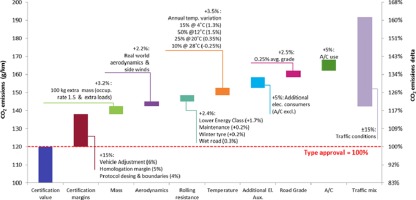当前位置:
X-MOL 学术
›
Prog. Energy Combust. Sci.
›
论文详情
Our official English website, www.x-mol.net, welcomes your feedback! (Note: you will need to create a separate account there.)
Fuel consumption and CO 2 emissions from passenger cars in Europe – Laboratory versus real-world emissions
Progress in Energy and Combustion Science ( IF 29.5 ) Pub Date : 2017-05-01 , DOI: 10.1016/j.pecs.2016.12.004 Georgios Fontaras , Nikiforos-Georgios Zacharof , Biagio Ciuffo
Progress in Energy and Combustion Science ( IF 29.5 ) Pub Date : 2017-05-01 , DOI: 10.1016/j.pecs.2016.12.004 Georgios Fontaras , Nikiforos-Georgios Zacharof , Biagio Ciuffo

|
Abstract Official laboratory-measured monitoring data indicate a progressive decline in the average fuel consumption and CO2 emissions of the European passenger car fleet. There is increasing evidence to suggest that officially reported CO2 values do not reflect the actual performance of the vehicles on the road. A reported difference of 30–40% between official values and real-world estimates was found which has been continuously increasing. This paper reviews the influence of different factors that affect fuel consumption and CO2 emissions on the road and in the laboratory. Factors such as driving behaviour, vehicle configuration and traffic conditions are reconfirmed as highly influential. Neglected factors (e.g. side winds, rain, road grade), which may have significant contributions in fuel consumption in real world driving are identified. The margins of the present certification procedure contribute between 10 and 20% in the gap between the reported values and reality. The latter was estimated to be of the order of 40%, or 47.5 gCO2/km for 2015 average fleet emissions, but could range up to 60% or down to 19% depending on prevailing traffic conditions. The introduction of a new test protocol is expected to bridge about half of the present divergence between laboratory and real world. Finally, substantial literature was found on the topic; however, the lack of common test procedures, analysis tools, and coordinated activity across different countries point out the need for additional research in order to support targeted actions for real world CO2 reduction. Quality checks of the CO2 certification procedure, and the reported values, combined with in-use consumption monitoring could be used to assess the gap on a continuous basis.
中文翻译:

欧洲乘用车的油耗和 CO 2 排放量——实验室排放量与实际排放量
摘要 官方实验室测量的监测数据表明,欧洲乘用车车队的平均油耗和二氧化碳排放量逐渐下降。越来越多的证据表明,官方报告的 CO2 值并不能反映道路上车辆的实际性能。发现官方值与真实世界估计值之间报告的差异为 30-40%,并且一直在增加。本文回顾了道路和实验室中影响油耗和二氧化碳排放的不同因素的影响。驾驶行为、车辆配置和交通状况等因素被再次确认为具有高度影响力。识别出可能对现实世界驾驶中的燃料消耗产生重大影响的被忽视的因素(例如侧风、下雨、道路坡度)。当前认证程序的余量对报告值与实际值之间的差距贡献了 10% 到 20%。后者估计为 2015 年平均车队排放量的 40% 或 47.5 gCO2/km,但可能高达 60% 或低至 19%,具体取决于当时的交通状况。新测试协议的引入有望弥合目前实验室和现实世界之间大约一半的分歧。最后,找到了有关该主题的大量文献;然而,不同国家之间缺乏通用的测试程序、分析工具和协调活动,这表明需要进行额外的研究,以支持现实世界二氧化碳减排的有针对性的行动。二氧化碳认证程序的质量检查和报告值,
更新日期:2017-05-01
中文翻译:

欧洲乘用车的油耗和 CO 2 排放量——实验室排放量与实际排放量
摘要 官方实验室测量的监测数据表明,欧洲乘用车车队的平均油耗和二氧化碳排放量逐渐下降。越来越多的证据表明,官方报告的 CO2 值并不能反映道路上车辆的实际性能。发现官方值与真实世界估计值之间报告的差异为 30-40%,并且一直在增加。本文回顾了道路和实验室中影响油耗和二氧化碳排放的不同因素的影响。驾驶行为、车辆配置和交通状况等因素被再次确认为具有高度影响力。识别出可能对现实世界驾驶中的燃料消耗产生重大影响的被忽视的因素(例如侧风、下雨、道路坡度)。当前认证程序的余量对报告值与实际值之间的差距贡献了 10% 到 20%。后者估计为 2015 年平均车队排放量的 40% 或 47.5 gCO2/km,但可能高达 60% 或低至 19%,具体取决于当时的交通状况。新测试协议的引入有望弥合目前实验室和现实世界之间大约一半的分歧。最后,找到了有关该主题的大量文献;然而,不同国家之间缺乏通用的测试程序、分析工具和协调活动,这表明需要进行额外的研究,以支持现实世界二氧化碳减排的有针对性的行动。二氧化碳认证程序的质量检查和报告值,



























 京公网安备 11010802027423号
京公网安备 11010802027423号